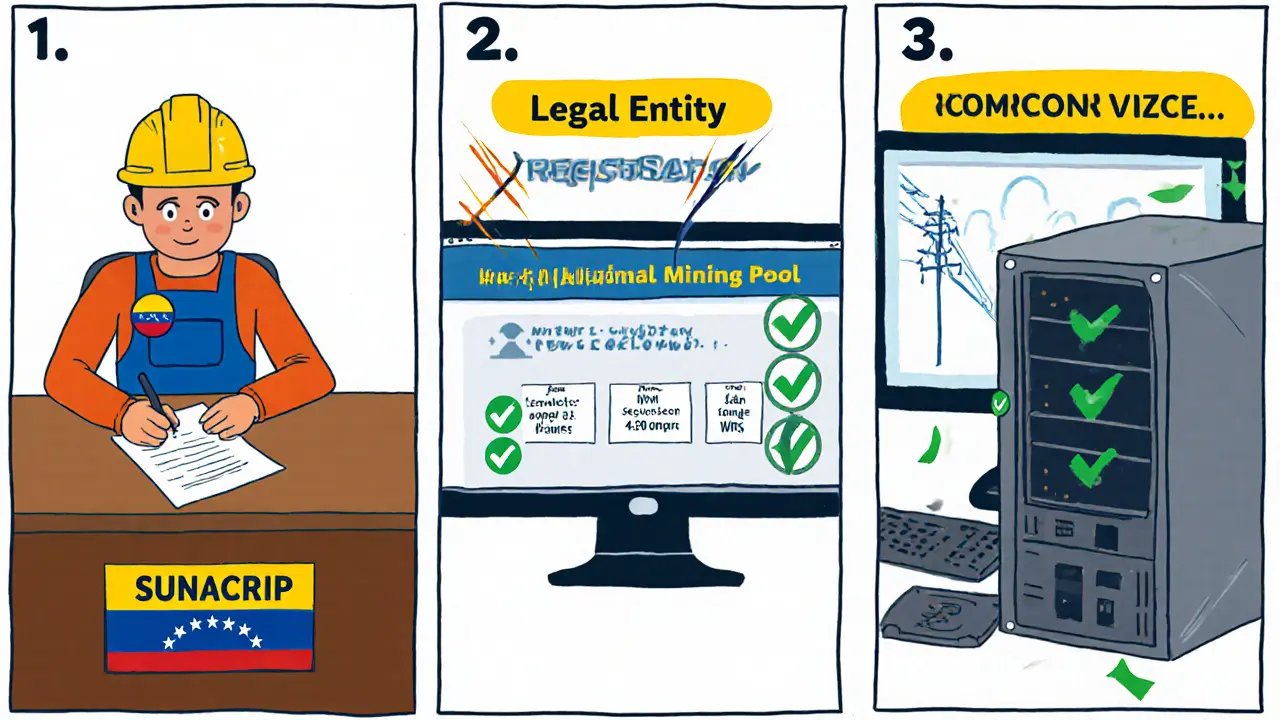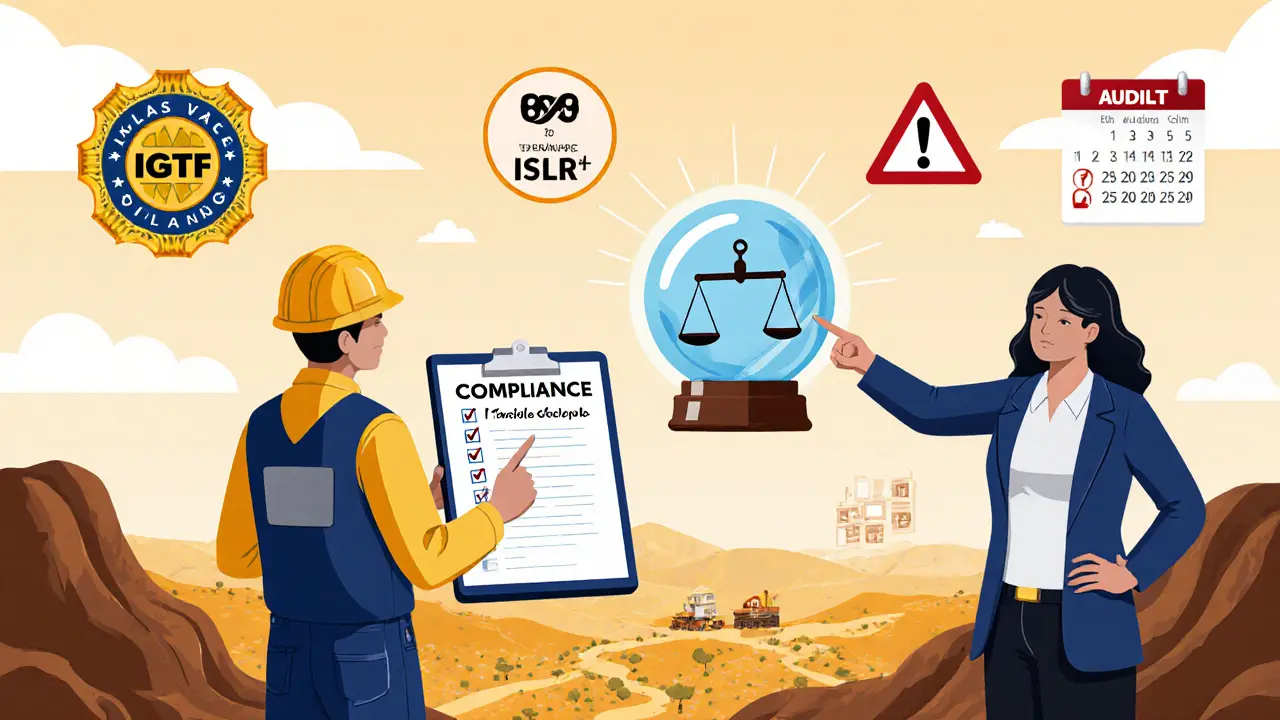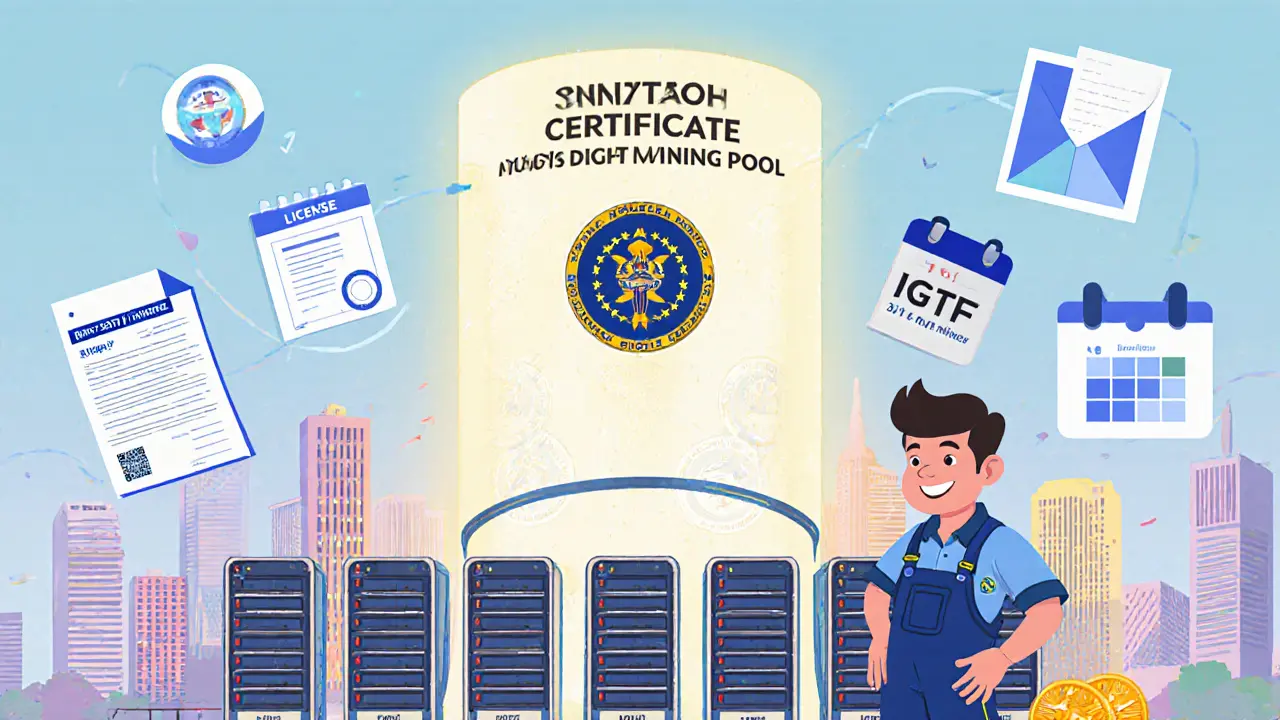Venezuela Mining Tax Calculator
Calculate Your Venezuela Mining Tax Obligations
Estimate your tax liabilities and compliance costs based on Venezuela's state-licensed mining system. This tool helps you understand the financial impact of SUNACRIP regulations, tax requirements, and compliance costs.
Key Takeaways
- All crypto miners in Venezuela must obtain a license from SUNACRIP (the National Superintendency of Crypto Assets and Related Activities) and join the government‑run National Digital Mining Pool.
- Licensing takes 3‑6months and requires a formal business entity, a detailed technical plan, and 10‑year record‑keeping.
- Taxes include the Large Financial Transactions Tax (IGTF) up to 20%, Income Tax (ISLR) on mining profits, and a 16% VAT on exchange fees.
- Non‑compliance can lead to equipment confiscation, frozen payouts, and heavy fines.
- Regulatory stability remains uncertain; miners should stay agile and keep legal counsel close.
Venezuela’s crypto mining scene is unlike any other country’s - the government runs a fully state‑licensed system that forces every miner into a single, centrally‑controlled pool. If you’re thinking about setting up a mining operation or navigating an existing one, you need to know exactly what the law demands, how to stay compliant, and where the biggest risks lie.
What the State‑Licensed System Actually Is
Venezuela state‑licensed crypto mining (a government‑mandated framework that requires all mining entities to obtain a license, register in the Integral Miners Registry, and operate through the National Digital Mining Pool) was formalized by a decree published on 22September 2023. The regime is overseen by SUNACRIP, which replaced the older SUPCACVEN agency in 2019.
The core idea is simple on paper: put every miner under one roof, track every hash, and tax the rewards directly. In practice it means you can’t mine independently, can’t export hardware without approval, and can’t keep your earnings private.
Step‑by‑Step Licensing Process
- Form a legal entity. Register a corporation or LLC with the Venezuelan Mercantile Registry. The entity must have a Venezuelan tax ID (RIF) and a bank account in bolívars or Petro.
- Prepare the application dossier. Include:
- Business plan and financial projections (minimum 1‑year outlook).
- Technical specifications of mining hardware (hash rate, power consumption, model numbers).
- Proof of electricity supply contracts and location details.
- AML/KYC compliance procedures for any future token sales or exchanges.
- Submit to SUNACRIP. Applications are filed online through the SUNACRIP portal. Expect a 3‑6month review period, during which officials may request additional documentation or site visits.
- Enroll in the Integral Miners Registry (RIM). Once the license is granted, you must be listed in the Integral Miners Registry (RIM). The registry acts as a master list of all approved miners.
- Integrate with the National Digital Mining Pool. Install the pool’s client software, configure your mining rigs to point to the government‑controlled server, and set up automated reporting of hash contribution and power usage.
- Maintain ongoing compliance. Submit monthly reports, keep detailed logs for ten years, and renew the license annually (renewal fee ~0.5% of declared hash power).
The National Digital Mining Pool - How It Works
The National Digital Mining Pool is a single, state‑run pool where all legal miners send their hash power. The pool aggregates rewards, deducts taxes, and distributes payouts according to each miner’s contribution record.
- Payment freezes. Authorities can halt payouts at any moment, often citing “audit” or “tax verification” reasons.
- Direct taxation. A flat 20% IGTF is deducted before any payout reaches the miner’s wallet.
- Transparency (for the state). Every hash, power draw, and reward is logged in real‑time, allowing the government to track individual earnings.
Operating outside the pool is illegal and can result in equipment confiscation and criminal charges.

Tax Landscape for Venezuelan Miners
Taxes are applied at several points in the mining lifecycle. Below is a quick reference of the main levies:
| Tax | Base | Rate | Who Collects |
|---|---|---|---|
| IGTF (Large Financial Transactions Tax) | Crypto transactions not in bolívars or Petro | Up to 20% | SENIAT |
| ISLR (Income Tax) | Net profit from mining or crypto sales | 15-30% (progressive) | SENIAT |
| VAT | Exchange service fees | 16% | SENIAT |
Because there is no specific crypto‑tax law, the general Income Tax Law treats crypto as an asset. This means you must calculate cost basis in bolívars, convert any sales to the local currency, and report the gain on your annual tax return.
Equipment Imports & Manufacturer Licensing
If you plan to import ASICs or GPUs, you need a separate license from SUNACRIP for hardware importation. The process mirrors the mining license but adds:
- Customs clearance paperwork approved by the Servicio Nacional Integrado de Administración Aduanera y Tributaria (SENIAT).
- Proof that the equipment will be used exclusively within the National Digital Mining Pool.
- An import duty waiver that is only granted after the mining license is active.
Manufacturers that want to sell locally must also obtain a “Special Equipment License” and register with CAVEMCRIP, the private‑sector body created during the 2024 SUNACRIP re‑organization.
Record‑Keeping, Reporting & Audits
Compliance is data‑heavy. You must:
- Log every hash submitted to the pool, along with timestamps.
- Track electricity consumption per rig (meter readings are mandatory).
- Maintain financial ledgers for all crypto inflows/outflows, kept for a minimum of ten years.
- Submit monthly PDFs to SUNACRIP via the secure portal; the files must be signed with a qualified digital certificate.
Random audits are announced via the SUNACRIP website. If selected, you’ll be required to present original hardware invoices, power bills, and the full ten‑year log on site.
Penalties for Non‑Compliance
- Equipment seizure. Unlicensed rigs are confiscated and may be auctioned by the state.
- Payment freeze or revocation. The National Digital Mining Pool can withhold payouts indefinitely.
- Fines. Up to 200% of the unpaid tax plus a fixed penalty of 10,000bolívars.
- Criminal charges. Repeated violations can trigger charges of “economic sabotage,” which carry prison terms.
Because enforcement has been inconsistent-some miners report months‑long freezes while others face immediate closure-risk management is essential.

Regulatory Timeline & Volatility
Understanding the recent history helps you gauge future risk:
- Sept2020 - Venezuela legalizes Bitcoin mining; SUNACRIP issues the first licensing guidelines.
- Mar2023 - SUNACRIP operations suspended amid a $3million corruption probe.
- 2024 - Complete mining ban announced, then lifted in March when SUNACRIP re‑organized.
- 2025 - SENIAT ramps up tax enforcement using KYC data from exchanges.
The pattern shows abrupt policy shifts. If you’re planning a long‑term project, budget for legal counsel and be ready to pause operations if a new decree arrives.
Practical Compliance Checklist
- ✅ Register a Venezuelan legal entity with RIF.
- ✅ Compile technical specs, power contracts, and AML/KYC policies.
- ✅ Submit the SUNACRIP license application (3‑6months).
- ✅ Enroll in the RIM and integrate with the National Digital Mining Pool.
- ✅ Set up a 10‑year digital archive (cloud + local backups).
- ✅ Register for IGTF and ISLR with SENIAT; keep exchange fee invoices for VAT.
- ✅ If importing hardware, obtain the import license and SENIAT clearance.
- ✅ Schedule quarterly internal audits to match SUNACRIP reporting cadence.
- ✅ Retain a local crypto‑law attorney for policy updates.
Future Outlook
Two forces will shape what happens next:
- Political stability. Any shift away from Maduro’s administration could either relax the regime or replace it with an even tighter control model.
- Economic pressure. Hyperinflation has forced many citizens onto crypto; the government may loosen rules to keep tax revenue flowing, or tighten them to protect the Petro.
For now, the safest bet is to treat the Venezuelan mining license as a high‑risk, high‑reward opportunity. Keep costs low, stay transparent, and have an exit strategy ready.
Frequently Asked Questions
Do I need a license if I only run a few GPUs?
Yes. The law does not differentiate by scale. Even a single GPU must be registered with SUNACRIP, listed in the RIM, and attached to the National Digital Mining Pool.
Can I mine a cryptocurrency other than Bitcoin?
The pool accepts any proof‑of‑work coin, but earnings are converted to the state‑approved token before distribution. Expect an extra conversion fee and IGTF on the transaction.
What happens if my payout is frozen?
The pool can freeze payouts indefinitely until you provide additional documentation or settle any outstanding tax liabilities. Many miners report weeks‑long delays, so keep cash reserves to cover operating costs.
Are there any tax deductions available?
You can deduct electricity costs, hardware depreciation (5‑year straight‑line), and any fees paid to SUNACRIP. These are reported on the ISLR return.
How can I stay updated on regulatory changes?
Subscribe to the official SUNACRIP bulletin, follow the Venezuelan Ministry of Digital Economy on Twitter, and retain a local legal advisor who monitors the Official Gazette for new decrees.


Thsi SUNACRIP tax nonsense is just a govt ploy to bleed miners dry.
When I tried to register my rig in Caracas, the lines were longer than a Netflix binge 🍿📜, and the officials kept asking for extra paperwork that never existed. It felt like a maze designed to keep us guessing.
Understanding Venezuela's state‑licensed crypto mining regime begins with acknowledging the SUNACRIP registration process, which can take anywhere from three to six months. First, prospective miners must submit a detailed application outlining hardware specifications, projected hash power, and anticipated electricity consumption. Upon acceptance, the Integral Miners Registry (RIM) issues a unique license number that must be displayed on all mining equipment.
Second, the tax structure comprises three primary components: IGTF, ISLR, and VAT, each calculated on different bases and with distinct filing deadlines.
Third, license and compliance fees are levied annually and must be paid before the fiscal year ends to avoid penalties.
Moreover, maintaining a ten‑year audit trail of all transactions, electricity invoices, and revenue statements is mandatory; failure to do so can trigger equipment confiscation.
Practically, miners should engage a local crypto‑law attorney to navigate bureaucratic nuances and to ensure that all documentation conforms to evolving regulations.
From a financial perspective, the IGTF (large financial transactions tax) applies at a rate of 3 % on all crypto‑related payouts, while ISLR is a progressive income tax that can reach up to 34 % based on net profit.
VAT, at 16 %, is imposed on the sale of electricity to the grid, which some miners offset by feeding excess power back to utility companies.
It is crucial to differentiate between gross revenue and net taxable income; operational costs such as electricity, cooling, and equipment depreciation are deductible under ISLR.
For electricity, miners should negotiate with local distributors to secure a preferential rate, as standard residential tariffs can render mining unprofitable.
Additionally, the government may offer tax incentives for renewable‑energy‑powered farms, which can lower the effective tax burden dramatically.
Compliance costs also include periodic on‑site inspections by SUNACRIP officials, who verify that miners adhere to power usage caps and anti‑money‑laundering protocols.
If any irregularities are detected, fines can soar up to 200 % of the unpaid taxes, and payouts may be frozen indefinitely.
Therefore, a robust risk‑management strategy, including insurance against equipment seizure, is advisable.
Finally, continuous monitoring of regulatory updates via official bulletins will keep miners ahead of sudden policy shifts.
In summary, while the Venezuelan mining landscape offers low electricity rates, the intricate licensing and tax regime demands meticulous planning, legal counsel, and disciplined record‑keeping to achieve sustainable profitability.
It's fascinating how Venezuela blends its rich cultural heritage with cutting‑edge crypto policy – the blend feels like a digital carnival where every step must be carefully choreographed.
Stay positive! Even with the paperwork, the low electricity costs can still make a modest rig profitable if you keep the books clean.
Great breakdown, Daron. Just add that keeping digital backups of all receipts can save you a lot of headaches later.
Don't be fooled, the whole SUNACRIP thing is a front for the regime to funnel crypto profits into secret state wallets. They'll track every hash you produce.
Honestly, the entire compliance maze sounds like a bureaucratic horror story – endless forms, vague deadlines, and the ever‑looming threat of confiscation.
Look, if you don't want to drown in red tape, just skip Venezuela. There are cleaner jurisdictions that actually reward miners.
While Leo’s frustration is understandable, it’s worth noting that many miners have successfully navigated SUNACRIP with the right legal partner. The key is patience and meticulous documentation.
From a cultural standpoint, embracing the local compliance spirit can open doors to community support and potential subsidies for renewable‑energy mining setups.
Hey folks, remember that the best way to stay afloat is to share knowledge – keep your compliance calendars updated and help each other avoid those nasty fines.
Seriously, the tax calculator is a lifesaver; it lets you see the real impact before you commit your hardware.
Brandon nailed it – use the tool, do the math, then decide.
The compliance steps are more straightforward than they appear once you break them down into weekly tasks.
i think its pretty simple, just follow the steps and dont miss any deadline.
💥 The real drama begins when the tax office shows up unannounced! Keep those records tight, or you’ll feel the sting. 😎